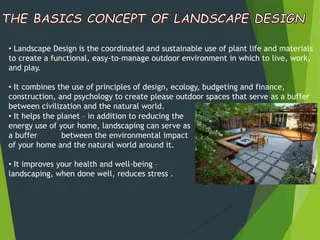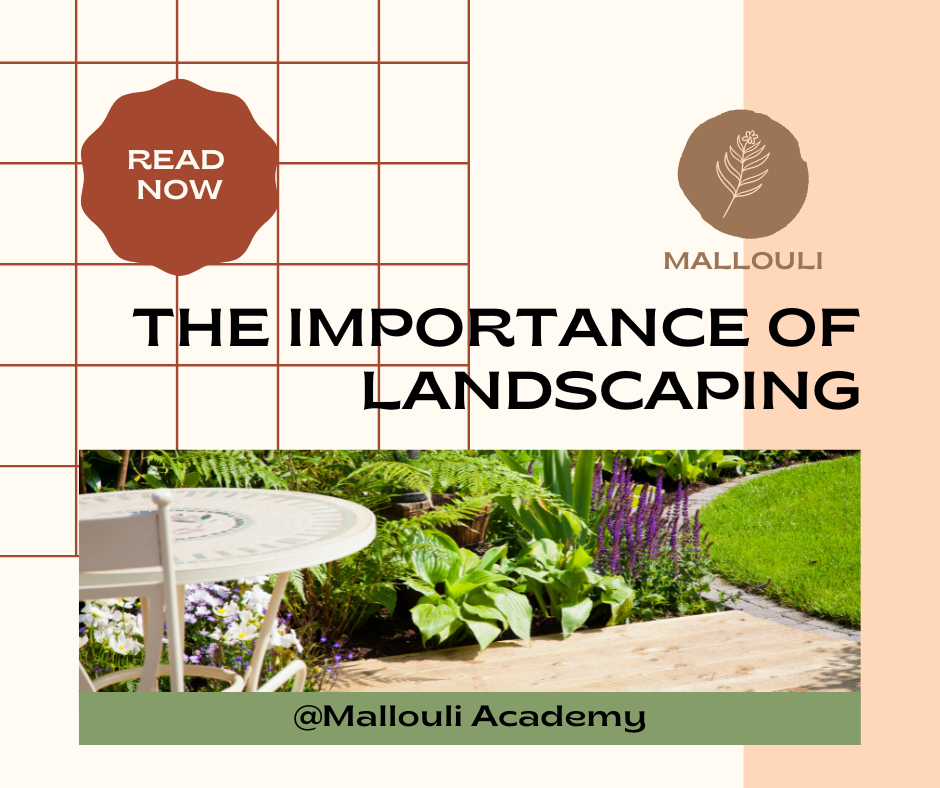The Landscape Design PDFs
The Landscape Design PDFs
Blog Article
Landscape Design Fundamentals Explained
Table of ContentsAll about Landscape DesignThe Ultimate Guide To Landscape DesignThe smart Trick of Landscape Design That Nobody is Discussing7 Easy Facts About Landscape Design ExplainedLandscape Design for Dummies
A yard can normally be divided right into 3 locations: public (the front yard), private (the back yard), and solution (typically the side yard). The location of task locations depends mostly on the type of area, the size of area required, the kind of activity, and the preferred closeness to various other activities and frameworks.The outside wall surface of your home frequently acts as the very first wall surface or starting point of an exterior room. Incompatible uses must be divided, and related tasks, such as cooking and eating, ought to be assembled to make the yard extra efficient and pleasurable. When making use of hardscape to produce spaces, make use of building product similar to that used in your house for continuity from the house right into the garden.
Linked areas. Debt: Gail Hansen, UF/IFAS Using similar hardscape features and repeating plants draws the eye around the garden.
The Only Guide to Landscape Design

For psychological convenience plants are used as physical or suggested obstacles for privacy and security. Physical obstacles block both the view and access to a space and consist of fencings, wall surfaces and plant hedges. Implied obstacles, typically reduced expanding plants, block access yet not the view (Figure 9). Various other functions of plants consist of cleansing the air, stopping erosion and dirt loss, maintaining dampness in the dirt, and returning organic issue to the dirt.
Physical and implied obstacles. Credit: Gail Hansen, UF/IFAS For these factors, the types of plants to be utilized (such as trees, bushes, or groundcovers) should be picked in the onset of planning (Landscape Design). Plant types are picked for their functional capacities to ensure that their future objective and required room can be considered at the exact same time

The Facts About Landscape Design Revealed
Each plant mass is in front of, behind, or next to, another mass. Credit Score: Gail Hansen, UF/IFAS Repeating plants within a mass and repeating masses with similar plants ties the garden together. The individual plant qualities need to be taken into consideration to efficiently layer and mass plants.
All plant make-ups start with the major framework plants, the big, primarily evergreen background plants-such as the trees and large shrubs. These plants separate or enframe spaces, control the size of the room, and give the beginning factor go to this site for picking the ideal features of the 2nd layer, midground plants, for massing and infill.
Crucial factors in the garden ought to be highlighted by the use distinct plants, distinct frameworks, or yard accessories. Marking thresholds or entrances to rooms can be performed with gateways, arbors, and actions, or with making use of one-of-a-kind and vibrant plants. The form and/or style motif of the garden will frequently help determine the vital factors and exactly how they should be highlighted.
Other important locations in the yard are focal factors, which is used to visually arrange a landscaped location. Different viewpoints or viewpoints can expose various structures in the landscape that might require a selection of focal points.
Not known Details About Landscape Design

Plant types. Credit Score: Gail Hansen, UF/IFAS After type, texture is the following leading feature of a plant; crude, medium and fine structures can be utilized for comparison and emphasis in the landscape.
The pleasant aroma of plants, the noise of wind in the trees, the sound and structure of water, and the colors and appearances of sculptures, pots and yard furnishings all add to the experience of the yard. One detail that is frequently overlooked is the impact of light on the looks of the plants.

9 Simple Techniques For Landscape Design
It is essential to understand the ultimate mature size of plants so they can be put in the right area and spaced correctly when they are set up. Providing plants space to expand is a challenge since the typical fully grown dimension is generally based on ideal expanding problems and the ecological conditions of a site may trigger a plant to enlarge internet or remain smaller.
Report this page